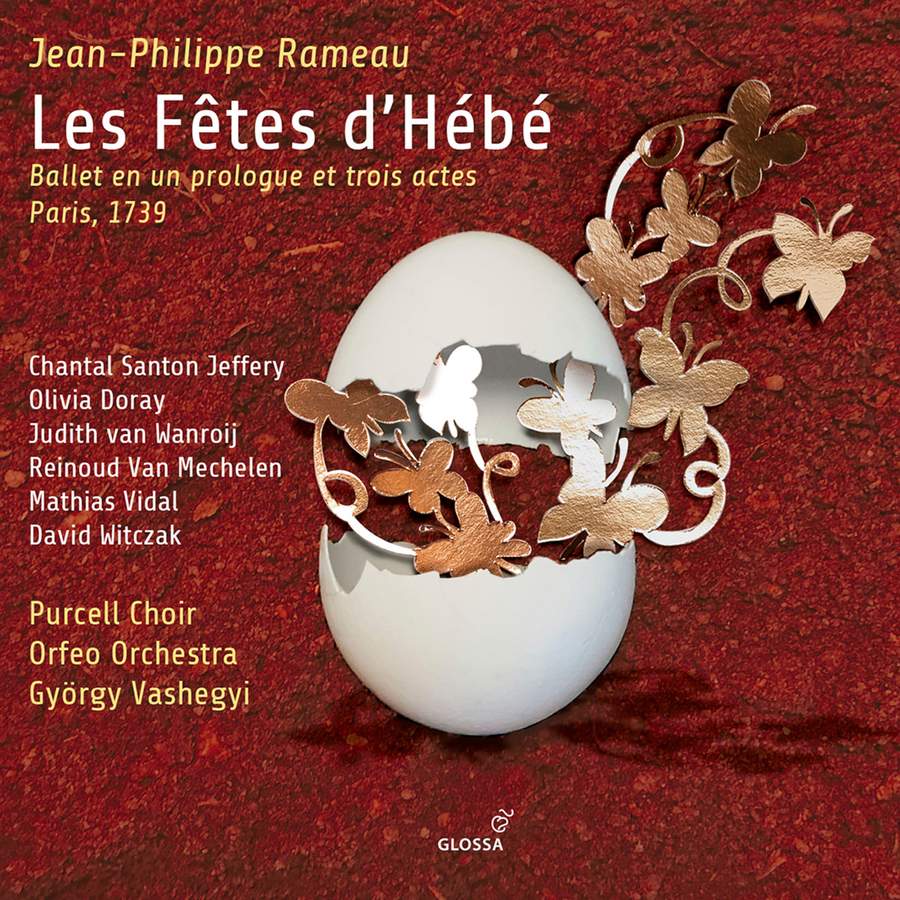RAMEAU Les fêtes d’Hébé (Vashegyi)
View record and artist detailsRecord and Artist Details
Genre:
Opera
Label: Glossa
Magazine Review Date: 09/2022
Media Format: CD or Download
Media Runtime: 176
Mastering:
DDD
Catalogue Number: GCD924012

Tracks:
| Composition | Artist Credit |
|---|---|
| (Les) fêtes d'Hébé (Les talents lyriques) |
Jean-Philippe Rameau, Composer
Chantal Santon-Jeffery, Hébé; Sapho, Soprano David Witczak, Alcée; Eurilas; Tyrtée, Baritone György Vashegyi, Conductor Judith Van Wanroij, Iphise, Soprano Lóránt Najbauer, Le Fleuve; Oracle, Baritone Marie Perbost, L’Amour; Eglé, Soprano Mathias Vidal, Lycurgue, Tenor Olivia Doray, Naïade; Iphise, Soprano Orfeo Orchestra Philippe Estèphe, Hymas; Tyrtée, Baritone Purcell Choir Reinoud van Mechelen, Momus; Mercure, Tenor |
Author: David Vickers
A quarter of a century since William Christie’s iconic 1997 Erato recording, an alternative take on Les fêtes d’Hébé is long overdue. In the 18th century the opéra-ballet was known by its subtitle Les talents lyriques because it depicts Hebe (goddess of youth) and her followers entertained by three entrées that represent lyric arts essential to the theatre. The first production (1739) ran for 71 performances, and during Rameau’s lifetime the work was performed another 129 times. Even after his death, some of its entrées continued to be performed at the Paris Opéra until 1777. György Vashegyi uses a new critical edition by musicologist Pascal Denécheau based on the June 1739 version; stinging criticisms in the wake of the premiere a month earlier led Rameau to substantially rewrite the second entrée, ‘La musique’.
The Orfeo Orchestra play the ouverture with vivacious personality. In the prologue, soft flutes mark the arrival of Cupid and the Graces with swaying sensuality, and a mercurial bourrée danced by Thessalians has percussion sprinkled judiciously. Chantal Santon Jeffery’s Hébé is by turns petulant, playful and graceful; a dance for Zephyr and the Graces features imaginative use of three flutes.
The first entrée, ‘La poésie’, concerns the poetess Sappho’s allegorical play designed to soften the heart of the king of Lesbos, who has been tricked into banishing her lover Alcée – her allegorical entertainment presents a melancholic Naiad, in love with a charismatic Brook, and their troubled fate is pitied by a River. Hunting horns are placed evocatively in the distance to announce the king’s arrival, there are several clever choruses for water dwellers, and celebratory tambourins, a gavotte and rondeau, and rigaudons are played superbly.
‘La musique’ portrays the supremely confident Tyrtée using the inspirational power of his singing to rouse the Spartans to victory in battle, thereby fulfilling the declaration of an oracle that the princess Iphise must marry a warrior who defeats the Messenians. Philippe Estèphe sings suavely in a celebratory arietta with trumpet and drums (‘Éclatante trompette’) that bursts into a bellicose chorus. In the meantime, Iphise’s pathos-drenched scene at the Temple of Hymen is sung impeccably by Olivia Doray. A delicate sarabande for Lacedaemonian women, a triumphant minuet featuring oboe and bassoon trio, a grand chaconne and a noble loure (with shaded horns and trumpets) are shaped and paced to perfection.
For good measure, the Budapest team also present the first version of ‘La musique’ in an appendix, and deploy different singers. In the original entrée, Iphise has more plaintive music to sing and also leads off ‘Éclatante trompette’, all of which suit Judith van Wanroij’s dramatically nuanced declamation. David Witczak brings gutsy rousing valour to Tyrtée, and Lycurgue (a character cut when Rameau revised the entrée) is sung muscularly by Mathias Vidal. There is an attractive ballet for Cupid and several genies, although its concluding chaconne could have been brought to life more vivaciously.
The entrée ‘La danse’ is a pastoral masterpiece. The shepherdess Eglé has to choose a husband and picks a handsome stranger who turns out to be Mercury; he persuades the Muse of Dance (Terpsichore) to accept Eglé into her court. Marie Perbost’s ardent Eglé, Reinoud Van Mechelen’s mellifluous Mercury (exploiting a brilliant range of vocal colours in the ariette ‘L’objet qui règne dans mon âme’), Chantal Santon Jeffery’s sweet shepherdess, the tender Purcell Choir and responsive Orfeo Orchestra combine lyrical talents charmingly. A musette en rondeau (its orchestration including an actual musette) and its connected duet and chorus are performed exquisitely. There are neither the rustic colours nor the engaging characterisations achieved memorably by Les Arts Florissants but Vashegyi and his orchestra cultivate translucent finesse that is in its own way irresistible.
Explore the world’s largest classical music catalogue on Apple Music Classical.
Included with an Apple Music subscription. Download now.

Gramophone Digital Club
- Digital Edition
- Digital Archive
- Reviews Database
- Events & Offers
From £9.20 / month
Subscribe
Gramophone Club
- Print Edition
- Digital Edition
- Digital Archive
- Reviews Database
- Events & Offers
From £11.45 / month
Subscribe
If you are a library, university or other organisation that would be interested in an institutional subscription to Gramophone please click here for further information.






